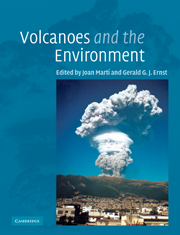Book contents
- Frontmatter
- Contents
- List of contributors
- Preface
- Acknowledgments
- Chapter 1 Understanding the physical behavior of volcanoes
- Chapter 2 Volcano hazards
- Chapter 3 Anticipating volcanic eruptions
- Chapter 4 Volcanoes and the geological cycle
- Chapter 5 Effects of volcanic eruptions on the atmosphere and climate
- Chapter 6 Volcanoes, hydrothermal venting, and the origin of life
- Chapter 7 Volcanism and mass extinctions
- Chapter 8 Effects of modern volcanic eruptions on vegetation
- Chapter 9 Animals and volcanoes: survival and revival
- Chapter 10 Human impacts of volcanoes
- Chapter 11 Volcanoes, geothermal energy, and the environment
- Chapter 12 Volcano-hosted ore deposits
- Chapter 13 Industrial uses of volcanic materials
- Chapter 14 Volcanoes, society, and culture
- Chapter 15 Volcanoes and the economy
- Index
- References
Chapter 15 - Volcanoes and the economy
Published online by Cambridge University Press: 14 November 2009
- Frontmatter
- Contents
- List of contributors
- Preface
- Acknowledgments
- Chapter 1 Understanding the physical behavior of volcanoes
- Chapter 2 Volcano hazards
- Chapter 3 Anticipating volcanic eruptions
- Chapter 4 Volcanoes and the geological cycle
- Chapter 5 Effects of volcanic eruptions on the atmosphere and climate
- Chapter 6 Volcanoes, hydrothermal venting, and the origin of life
- Chapter 7 Volcanism and mass extinctions
- Chapter 8 Effects of modern volcanic eruptions on vegetation
- Chapter 9 Animals and volcanoes: survival and revival
- Chapter 10 Human impacts of volcanoes
- Chapter 11 Volcanoes, geothermal energy, and the environment
- Chapter 12 Volcano-hosted ore deposits
- Chapter 13 Industrial uses of volcanic materials
- Chapter 14 Volcanoes, society, and culture
- Chapter 15 Volcanoes and the economy
- Index
- References
Summary
Introduction
Volcanic eruptions can have significant economic implications, both nationally and for individual households and communities. However, the nature and magnitude of such impacts are dependent on a number of factors. These include the precise nature of the volcanic activity; the timing of various eruptive phases relative to climatic seasons and agricultural and other cyclical economic activities (e.g., tourism); population density and types of economic activity in the affected area; and its economic significance for the rest of the country. Economic performance in the period immediately prior to an eruption, both nationally and internationally, can also play some role.
As a preliminary exercise in examining the economic impacts of volcanic activity, it is useful to consider the distinction commonly made between sudden-impact and slow-onset natural disasters. The former involve sudden, short-lived, destructive events, causing potentially severe damage to infrastructure, factories, and other productive capital, effectively destroying the means of production. They also affect social infrastructure, including housing. In the short term they are therefore potentially more disruptive to an economy than slow-onset disasters, which basically comprise droughts. However, the reverse is true in the longer term as the typically lengthier duration of slow-impact disasters can affect underlying economic variables such as levels of savings, investment, and domestic demand, as well as having a direct severe impact on water-intensive sectors.
Volcanic hazards are conventionally classified as sudden-impact disasters. However, at least from an economic perspective, they can display certain characteristics of slow-onset as well as sudden-impact disasters.
- Type
- Chapter
- Information
- Volcanoes and the Environment , pp. 440 - 467Publisher: Cambridge University PressPrint publication year: 2005
References
- 1
- Cited by



